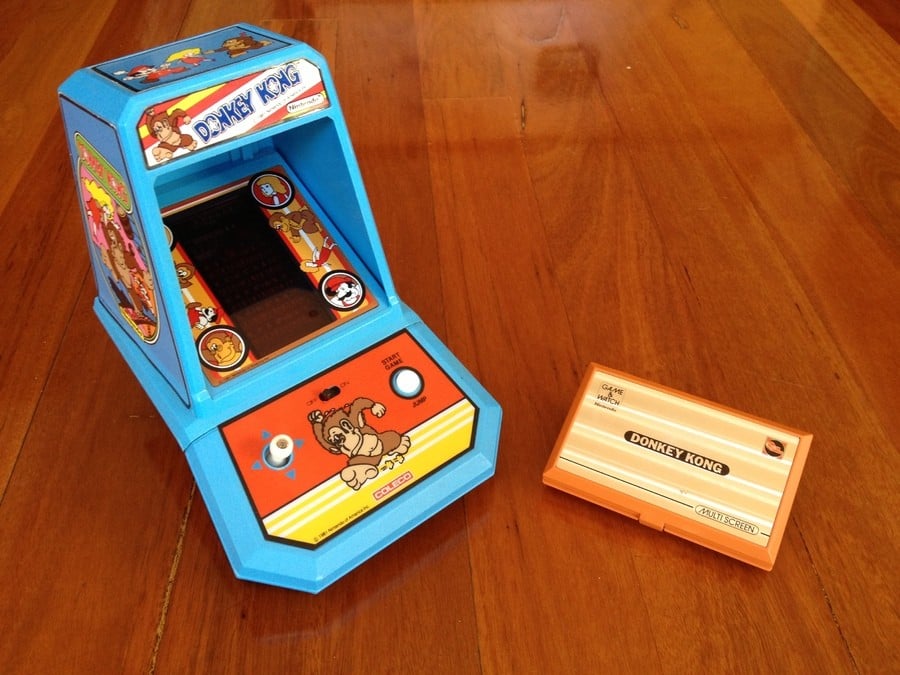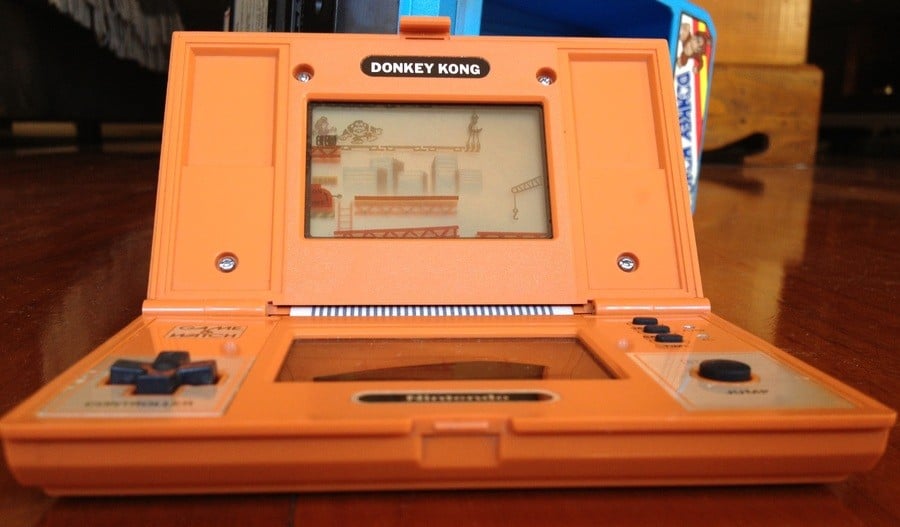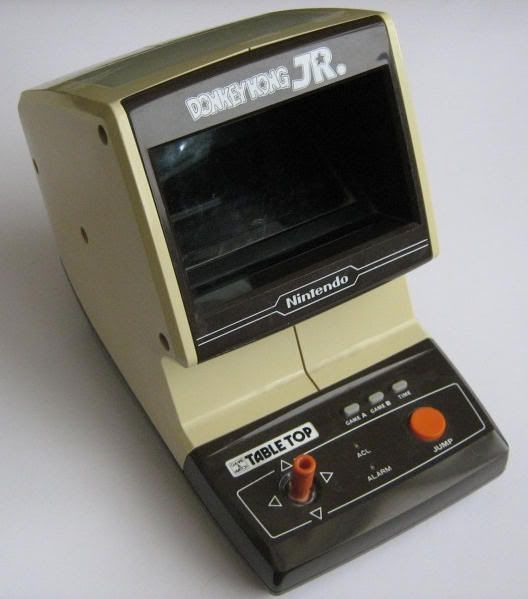
During the arcade boom of the early 1980s, Donkey Kong was doing great business for Nintendo. To capitalise on this popularity, miniature versions of the arcade game were released. First, there was Coleco’s Donkey Kong tabletop, followed by Nintendo’s Game & Watch Multi Screen version.
We decided to pit these ‘portable’ versions of Donkey Kong against each other; we grabbed our ‘C’ and ‘LR44’ batteries, whacked them in their respective units, and let them battle it out.
Round 1: Aesthetics
Round 1, Fight!
Anyway, playing Donkey Kong on the tabletop is rather cool. The unit literally looks like a miniaturised Donkey Kong arcade machine - there is a joystick to move Jump Man (a.k.a. Mario), and a fire button to jump over the barrels thrown down by DK (as he is affectionately known these days). The use of the vacuum fluorescent display (VFD) is good in theory (it is bright), but it lacks personality – after all, it was designed for calculator displays. The sounds emanating from the machine are your basic bleeps, which are nice and crisp. A clever touch is the instructions glued to the battery cover - just in case you lose the original manual. If you want to impress friends, then you can’t go wrong with this cool looking tabletop.
How can Gunpei Yokoi’s masterpiece, the Game & Watch (G&W), compete against Coleco’s offering in the looks department? Well, the orange DK multi-screen is the epitome of early '80s portable design. It is small enough to fit in your pocket, the LCD is clear, it has great battery life, and the controls are sublime – but more on that in round 2. The clam shell of the G&W multi-screen provides the perfect means to protect the unit. Just like the tabletop, this is one gorgeous unit.
It is difficult to compare the units, as they are so very different and they both look great.
Winner: DRAW
Round 2: Controls
This is the round where the two DK units start to diverge. On the Coleco, the joystick has minimal ‘give’, which feels like the player is disconnected when manoeuvring Mario. The jump button seems to have lag – which exacerbates the poor detection system. Mario’s jumping has to be timed by a precision marksman to ensure he jumps over the barrels; otherwise it is curtains.
On the flipside, the G&W controls feel like second nature – the Digital Pad (D-Pad) is responsive and it feels ‘just right’ when using your left thumb to move Mario across the screen. The jump button is also in a perfect position for your right thumb to use; unlike the Coleco equivalent, there's no lag when you press jump. The connection the player feels with the controls is vital; just like a pilot at the controls of a plane, they must feel like an extension to your body and they must be responsive, otherwise the experience won’t be pleasant. In this round, the G&W lands a right hook to the Coleco’s chin.
Winner: Game & Watch
Round 3: Gameplay
This third and final round is the most important, and it’s all about gameplay. The G&W version of DK is extremely playable, even with the limited game modes (Game A and Game B – Game B being of higher difficulty). The game is split on two screens; the top screen has DK holding Pauline hostage and throwing barrels, which roll down towards the bottom screen where Mario is about to set off on his adventure to topple Donkey Kong and save his girlfriend. Mario begins by jumping over barrels, avoiding girders and climbing up ladders to make his way to the top screen. Here, Mario has to time everything to perfection – flicking the lever to set off the swinging hook on the crane, run and jump to catch the swinging hook and remove one of the anchoring wires from the platform which Donkey Kong is standing on. This gameplay is repeated until the game is ‘clocked’. That may seem tedious and repetitive, but be assured, you will be playing it over and over – even if it is just to beat your previous best score.
In the Coleco corner, there is nothing worth shouting from the rooftop. With the use of the VFD, there is limited capacity to depict the characters and objects. Couple the poor visuals with even poorer controls, and you can see where this is going. If only Coleco paid as much attention to the gameplay as it did to its aesthetics, perhaps this round might have finished differently. Sadly, you will not want to play this game beyond 10 seconds, because that is how long one game will last. The G&W lands the mortal blow to the Coleco.
Winner: Game & Watch
And the winner is...

It may be obvious which unit wins this fight, but let us recap for old times’ sake. The Coleco miniature arcade tabletop may look awesome, but it is let down by poor controls, an unforgiving detection system, and gameplay you wouldn’t subject your worst enemy to. This version of DK screams “all looks and no substance”. It doesn’t play anything like the arcade version. If you want a vintage ornament to go on your shelf, then Coleco’s Donkey Kong tabletop would be a great choice. However, if you want a unit that looks cool, is portable, sleek, plays like a dream and doesn’t suck batteries like a blood starved leech, then the G&W version of DK is the one to go for. It can even be used as an alarm clock!
Overall winner: Game & Watch





Comments 39
I just saw two of the tabletops at auction by me I never knew what the ended up selling for but theyrebpretty neat
get the Donkey Kong Jr table top - best of both worlds and a Nintendo product

I don't have the tabletop but I do have the Game and Watch Donkey Kong kicking about somewhere. I must dig it out!
I remember my friend owning a tabletop DK game, and bringing it to school everyday to play, that things was absolutely amazing, hands down that things better.
Still have my "Donkey Kong II" Game & Watch. It was in fact my very first Nintendo game! Nothing like starting out with Mario as the bad guy. https://fbcdn-sphotos-g-a.akamaihd.net/hphotos-ak-ash3/154505_10150826265189370_456811316_n.jpg
Donkey Kong game boy is still the best.
Back in the day, the Coleco tabletop games were awesome products. I remember being so jealous of that one rich kid in the neighborhood (i think everyone knows one of those — the kid whose parents got him everything) who had a bunch of them. Donkey Kong definitely wasn't the best, but Pac-Man was awesome.
I had a lot of fun with the DK tabletop growing up. It may be limited, but it was fun.
I still have my DK tabletop upstairs. I bring it down and play it every once in a while. If you push up and turn it on at the same time it makes this loud beep like sound and it starts you on a wicked hard level, the score will look a little messed up and you'll have tons of lives, not unlimited but I think it's around 30. I remember coming across that by accident when I was a kid.
@Shiryu Fixed it.
I had both when I was young. I had Coleco's Pac-Man table top as well, which was really nice because you could play 2 Pac-Mans at the same time (made for 2 players, but that didn't stop me).
i never was into these
I disagree. I own both of these, and I like Coleco's table top version better. You forgot to mention it is in color and backlit. I own a lot of the Coleco table tops including: Frogger, Donkey Kong, Galaxian, Pac-Man, Ms. Pac-Man, Donkey Kong Jr., Zaxxon, & Q*bert. Expect to pay a lot on ebay to own these in decent shape. Well worth it though;)
@KnightRider666 Coleco table tops where awesome and the closest thing to arcade at home, at that time. I've seen alot on ebay for high prices, but they are definitely high prices for a reason, there just sooo great and any gamer should at least own one of these in their collect, I still play the Donkey Kong one every so often
@hydeks: Hell yeah! Glad to see somebody shares my appreciation for these awesome treasures from the 80's. My parents never bought any of these for me. I had to buy them all myself a few decades later. I still remember how badly I wanted the Donkey Kong one when I saw some kid playing with it in elementary school.
I'm right there with you KnightRider666 and hydeks. I also never had any of these when I was a kid, but I really, really wanted them. of course I also remember some rich friends had them. I remember someone had Coleco Pac-Man and I loved playing it. was there a Tron? I remember a Tron tabletop. I really do need these now.
btw KnightRider666, I am adding your 3DS code so that we can stay in contact.
@ZIMMS

Are you thinking of this one, perhaps?
Awesome article I had a good laugh at the various lines refering to them fighting like "In this round, the G&W lands a right hook to the Coleco’s chin." Hopefully there are many more "VS." articles to come haha
@ZIMMS: Cool beans! I just added you, and I'm awaiting your response to seal the deal:)
I had no idea those table tops existed. I managed to play the G&W DK like 20 years ago.
Love the last pic where the "losing" tabletop is down for the count behind the Game and Watch.
I remember seeing kids at my school with both the Coleco one and the Game and Watch one. Sadly though I was never one of those kids cause my parents would only get me the Tiger Electronic hand held games if anyone remembers those.
Wow what treasures. DK was always a favorite for me and I believe it was the very first nintendo game I have ever played. I still see the original DK at arcades that haven't been updated in a while. Thats when I realize I have no loose change.
Tasuki, Tiger handhelds were actually pretty cool. I'm sure many of us who were alive then had those as they were a lot less expensive. I would also bet most of us remember them fondly.
Yeah the tiger handhelds were the ones I had when I was kid ... Love the football game .. Played that for hours... Honestly didn't know about the portable table tops ... Nice article!!
I've got that g&w donkey kong!
my dad got me it when I was 9! wow that was a long time ago!
I commend that little gold box, I still have it and it still works. & it's still fun.
bleep,blip,blip,blip,blip,bleep,blip,blip,chzeegggqzxxxxxxxxxxxxxblip,...bleep,bliip,blip,blip,bleeep,blip
Never had a tabletop but I had G&Ws and they were rad. I can't say G&W is better though if I never l played the other to compare.
P.S. Colour doesn't mean anything. I mean, GB Tetris is one of the best Tetris games ever.
Hey! I remember playing that Coleco one!
I got the game & watch version on my 3ds.
Oh, this brings back memories! The DK tabletop was, best I remember, my first play-at-home video game! Must've been late '83, or early '84!
Of course, I had no concept of good play controls. I just knew your timing had to be perfect, or you were a goner! How far video games have come!
@Tasuki: Most definitely! I loved the blue pinball one. I recently bought Mega Man 2 and Mega Man 3. There's still without a doubt a nostalgia factor there:)
@WiiLovePeace glad you liked the article. There will be more "VS" battles in the near future.
@ausretrogamer awesome! Can't wait
@KnightRider666: Yeah I had the Altered Beast wrist watch one the Megaman 2 handheld one and a few others that I cant remember at the moment. I couldnt stand those to be honest I had a whole bunch of them that I just played once or twice and threw them in a draw. I gave them to Goodwill about 10 years ago when I moved out of my parents house.
very good article
OMG, I remember that mini DK arcade in Gremlins, when a couple of the Mogwai were playing with 1.
More features like this, please. I enjoy looks at older hardware.
@Tasuki: You gave them away? Damn, You should've sold'em all on ebay. You would've gotten something for them. I paid $20 for MM2 and $30 for MM3!
@Tomatoboxer there are more of these old school battles in the planning. Stay tuned
aahhhh, the orange G&W Donkiey Kong multi screen. This is where my gaming started back in 1984. I was in grade 1. I remember being sick in bed and my mom surprising me with a brand new one when she got home from the shops. Thanks Mom, you're the best.
Show Comments
Leave A Comment
Hold on there, you need to login to post a comment...